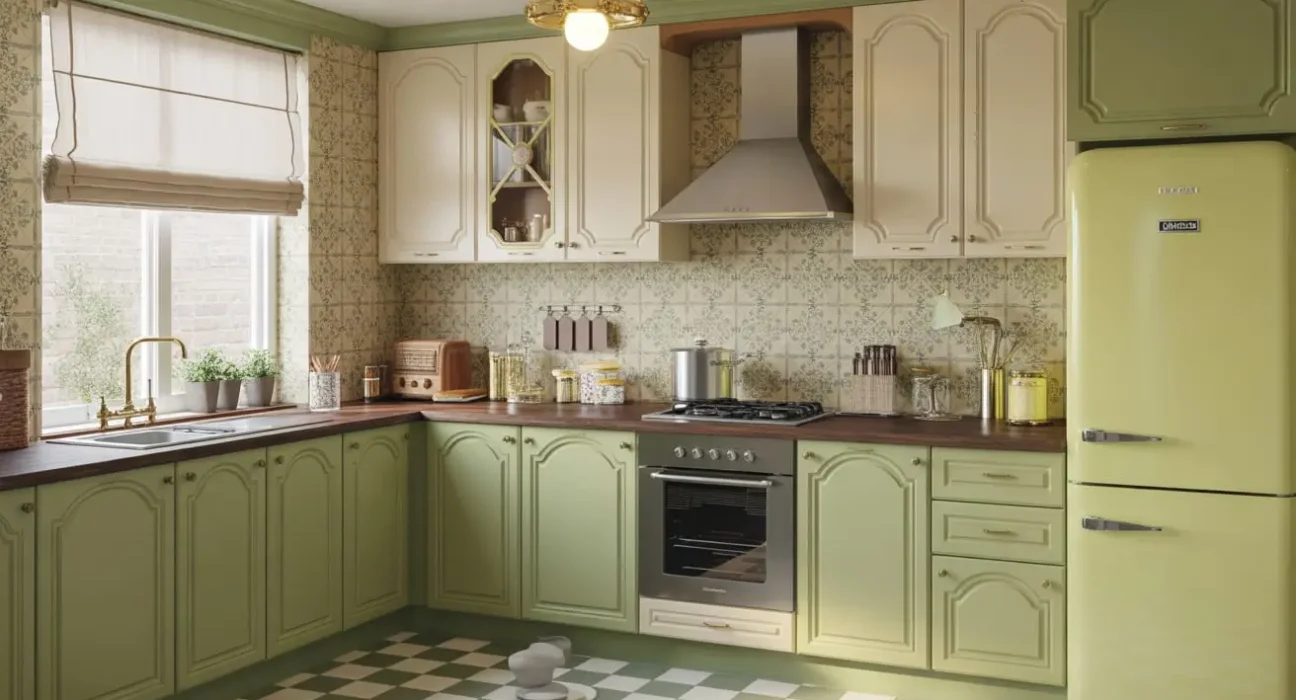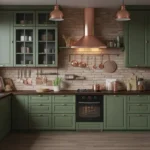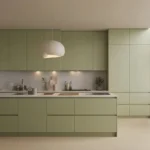You know that feeling when you walk into a kitchen and immediately feel like you can breathe? That’s sage green working its magic. I’ve been obsessed with this color lately, and honestly, if you’re not considering it for your kitchen, you’re missing out on one of the most versatile, calming hues that somehow manages to be both trendy and timeless (a rare combo, trust me).
Sage green isn’t your grandma’s mint—it’s sophisticated, earthy, and pairs beautifully with basically everything. Whether you’re planning a full kitchen renovation or just want to refresh your space without breaking the bank, these 15 ideas will get your creative juices flowing. Let’s jump right in!
Sage Green Shaker Cabinets with Brass Hardware

Can we talk about how shaker cabinets never seem to go out of style? Pair them with sage green, and you’ve got yourself a kitchen that screams elegance without trying too hard.
The clean lines of shaker-style cabinets create the perfect canvas for sage green paint, and when you add brass hardware, the whole look elevates instantly. I’m talking about that warm, golden brass that catches the light just right. The combination feels both traditional and fresh—like you respect classic design but aren’t afraid to make it your own.
Here’s what makes this combo work so well:
- Timeless appeal: Shaker cabinets have been around forever and won’t look dated in five years
- Warmth factor: Brass adds that cozy, lived-in vibe that makes a kitchen feel like home
- Versatility: This look works in everything from a Victorian rowhouse to a modern suburban home
Pro tip? Go for unlacquered brass if you’re feeling adventurous. It develops a patina over time that adds character. Sure, it requires a bit more maintenance, but the personality it brings is worth it, IMO 🙂
Modern Minimalist Sage Green Kitchen
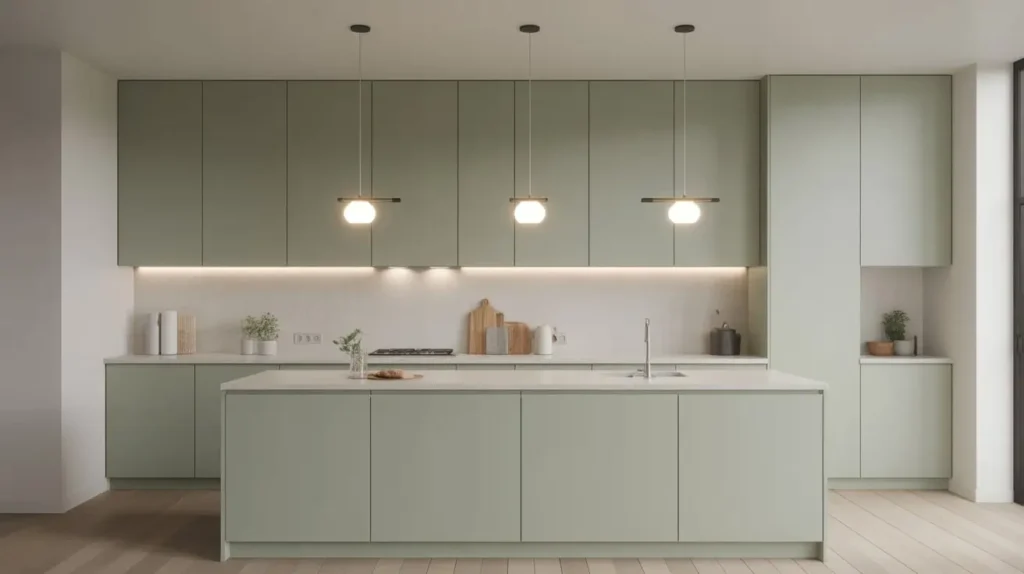
Ever wonder why minimalist kitchens always look so expensive? It’s because they don’t try to do too much, and sage green fits perfectly into this aesthetic.
Picture this: flat-panel sage green cabinets with integrated handles (or none at all), sleek white countertops, and absolutely zero clutter on the surfaces. The sage green here acts as a subtle pop of color without disrupting the clean, streamlined vibe.
In a minimalist kitchen, every element earns its place. The sage green shouldn’t be loud or in-your-face—think muted, dusty sage rather than bright herb garden. Pair it with:
- Handleless cabinets for that seamless look
- Quartz or solid surface countertops in white or light gray
- Minimal open shelving with just a few carefully curated pieces
- Stainless steel appliances that disappear into the design
The beauty of this approach is that your kitchen becomes this serene, zen space where cooking feels less like a chore and more like therapy. And who doesn’t need that?
Sage Green and White Farmhouse Kitchen

Okay, I know farmhouse style has been everywhere for the past decade, but hear me out—sage green breathes new life into this beloved aesthetic.
The classic farmhouse kitchen gets a sophisticated upgrade when you swap out the typical all-white or gray-blue for sage green lower cabinets paired with white uppers. This two-tone approach keeps things bright and airy (which is crucial in farmhouse design) while adding depth and interest.
What really makes a farmhouse kitchen sing:
- Apron-front sink: Preferably in white porcelain or fireclay
- Butcher block countertops: The warm wood tones complement sage green beautifully
- Open shelving: Display your vintage dishes and mixing bowls
- Shiplap or beadboard details: Because is it even a farmhouse kitchen without some texture?
I’ve seen this combination in person, and let me tell you, the sage green makes the space feel less “Pinterest 2015” and more “timeless country charm.” It’s fresh without abandoning the cozy, welcoming vibe that makes farmhouse kitchens so appealing.
Two-Tone Sage Green and Wood Cabinets
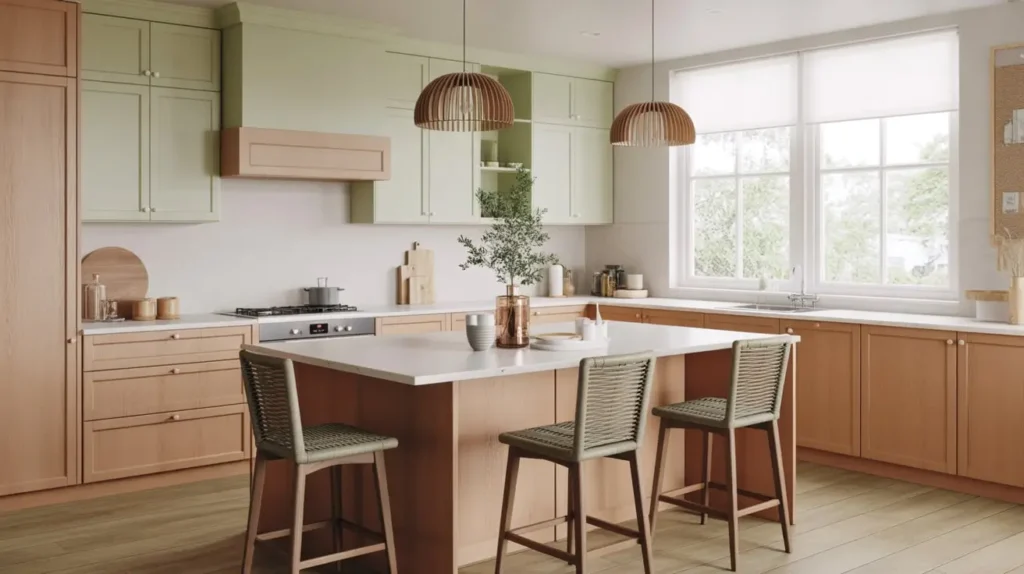
Why commit to one look when you can have two? Two-tone kitchens have become hugely popular, and for good reason—they add visual interest without overwhelming the space.
My favorite take on this? Sage green lower cabinets with natural wood uppers. The earthy green grounds the space while the wood adds warmth and prevents things from feeling too cool-toned. This combination works especially well if you have good natural light, as it brings out the beauty in both materials.
Consider these wood options:
- Light oak: Keeps things bright and Scandinavian-feeling
- Walnut: Adds richness and drama
- Maple: Offers a subtle grain that doesn’t compete with the green
- Reclaimed wood: For that eco-friendly, lived-in character
The key here is balance. You don’t want the wood to be so dark that it creates a heavy feeling, nor so light that the contrast disappears. Test samples in your actual kitchen lighting before committing—lighting makes a massive difference in how colors appear!
Sage Green Kitchen with Marble Countertops

Nothing says luxury quite like marble, right? Pair it with sage green cabinets, and you’ve got a kitchen that belongs in an interior design magazine.
White marble with gray veining creates this stunning contrast against sage green cabinets. The cool tones in the marble complement the earthy green perfectly, creating a sophisticated color story that feels both fresh and classic.
Now, let’s be real about marble for a second:
- It’s gorgeous but high-maintenance (it stains, it etches, it requires sealing)
- It’s expensive (but there are great porcelain alternatives that mimic the look)
- It adds instant elegance that’s hard to replicate with other materials
If you’re worried about marble’s durability, consider using it just on the island while choosing a more practical material like quartz for the perimeter counters. You get that wow factor without the constant stress about lemon juice destroying your investment.
The sage and marble combo works especially well in traditional or transitional kitchens where you want that refined, pulled-together look.
Also Read: 15 Elegant Dark Green Kitchen Ideas You’ll Fall in Love With
Cozy Cottage-Style Sage Green Kitchen

Picture a kitchen in the English countryside—that’s the vibe we’re going for here. Cottage-style kitchens are all about charm, character, and feeling like you’ve stepped into a cozier, simpler time.
Sage green painted cabinets (maybe slightly distressed if you’re feeling adventurous) set the foundation for a cottage kitchen. But the magic is really in the details. Think glass-front cabinets displaying pretty dishes, a vintage-style range, and maybe some floral curtains at the window.
Essential cottage kitchen elements:
- Vintage-inspired fixtures: Farmhouse faucets with a bridge design
- Patterned tile: Maybe a floral or geometric pattern in the backsplash
- Mismatched hardware: Who says all your knobs need to match perfectly?
- Cozy textiles: Tea towels, a small rug, maybe seat cushions if you have breakfast nook seating
I love how cottage style gives you permission to be a bit eclectic. That random piece of furniture you found at a flea market? It probably fits perfectly. The sage green ties everything together while keeping the space from feeling too busy or chaotic.
Sage Green Cabinets with Open Shelving

Open shelving—you either love it or you’re terrified of the dust situation. I fall somewhere in the middle, but I can’t deny how gorgeous it looks when done right.
Replacing some upper cabinets with open wooden shelves against sage green lowers creates an airy, accessible feeling. You show off your beautiful dishes and glassware while the sage green cabinets below provide plenty of hidden storage for the less photogenic stuff (we all have that random collection of mismatched Tupperware).
Making open shelving work:
- Edit ruthlessly: Only display items that look good and earn their place
- Create visual rhythm: Vary heights and group items in odd numbers
- Keep it practical: Put everyday items on lower shelves, pretty but rarely-used stuff up high
- Style with purpose: Mix functional items with decorative pieces
FYI, the secret to Instagram-worthy open shelving is actually using your dishes. When things get moved around regularly, the display feels lived-in rather than staged. Plus, sage green provides such a beautiful backdrop that your white dishes and glassware really pop.
Sage Green Kitchen with Gold Accents

If brass feels too rustic for your taste, let’s talk about gold. Specifically, brushed gold or champagne gold finishes that add glamour without going full Vegas.
Sage green cabinets with gold hardware, gold faucets, and maybe even gold light fixtures create this luxe, elevated look that feels special every single day. The warmth of gold complements the earthy undertones in sage green beautifully.
Gold accent ideas:
- Cabinet hardware (obviously)
- Faucet and sink fixtures
- Pendant lights over the island
- Bar cart or open shelving brackets
- Picture frames or small decorative objects
The trick with gold is restraint. You want enough to make an impact but not so much that it overwhelms. Think jewelry—you wouldn’t wear every piece you own at once, right? Same principle applies here.
This combination works particularly well in kitchens with plenty of natural light, as the gold catches and reflects the light, making the whole space feel brighter and more expensive.
Matte Sage Green Cabinets with Black Fixtures
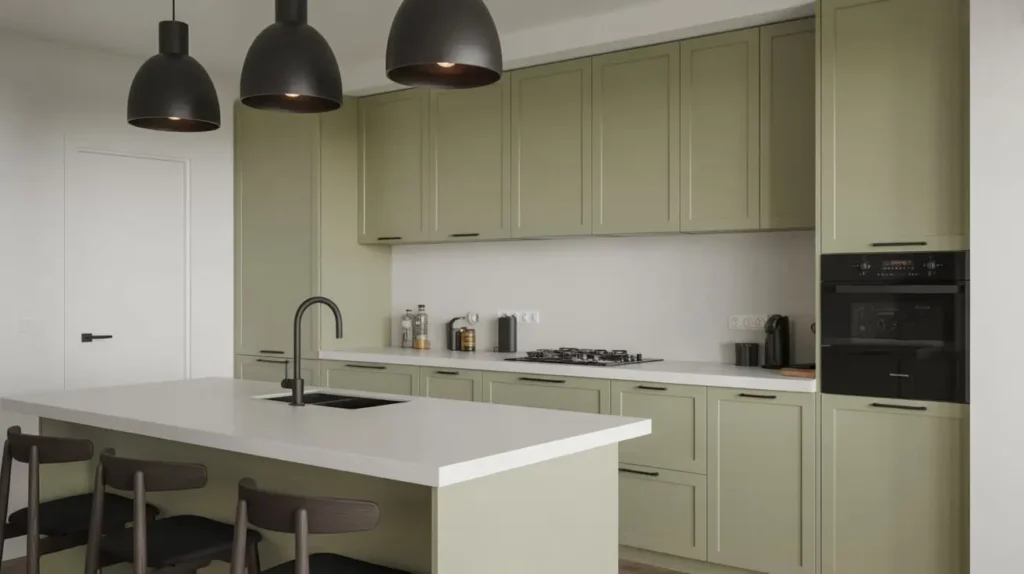
Want something a bit more dramatic? Black fixtures against matte sage green cabinets create a modern, moody vibe that’s totally trending right now.
The matte finish on the cabinets is crucial here—it creates this soft, velvety look that feels contemporary and sophisticated. Then you bring in black hardware, black faucets, maybe black window frames, and suddenly you’ve got this striking contrast that makes both colors pop.
Why this combo works:
- Modern edge: Black adds definition and prevents sage from feeling too soft or cottagecore
- Visual grounding: Dark elements anchor the space
- Versatility: Works in both modern and traditional settings
- Trend-forward: Matte black fixtures are having a major moment
I’ve noticed this look works especially well in kitchens with white or light-colored walls and countertops. The sage and black create the drama, while the lighter elements keep things from feeling too dark or cave-like.
Just a heads up—matte black fixtures do show water spots more than other finishes, so if that’ll drive you crazy, maybe reconsider :/
Sage Green Kitchen with Subway Tile Backsplash
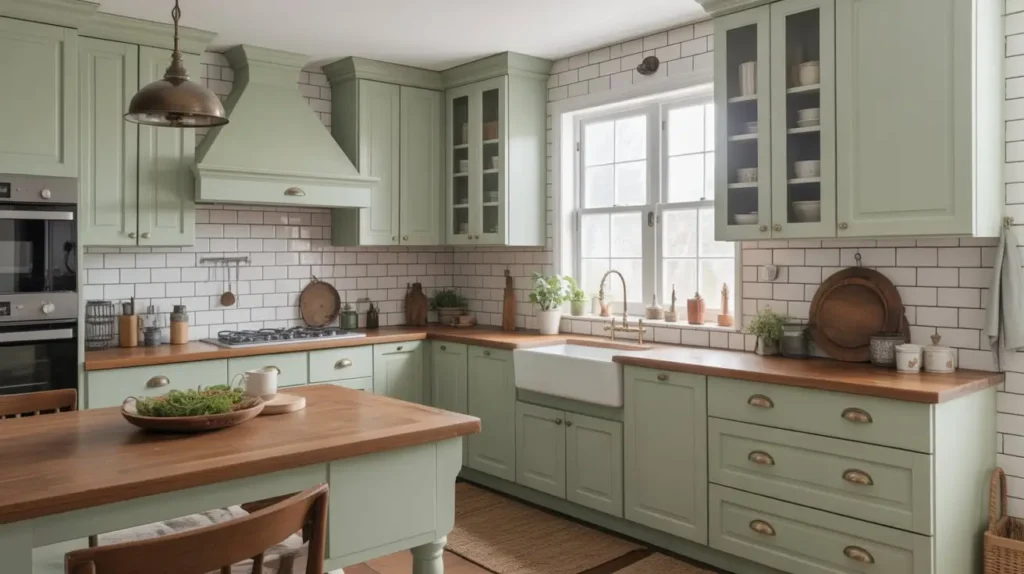
Sometimes the classics are classic for a reason, you know? White subway tile is everywhere, but it pairs so beautifully with sage green that I can’t ignore it.
Simple white subway tile provides a clean, crisp backdrop that lets your sage green cabinets be the star. The neutral backsplash also means you have more flexibility with other elements like countertops, flooring, and accessories.
Subway tile variations to consider:
- Classic 3×6 brick pattern: Timeless and clean
- Vertical stack: More modern and elongates the wall
- Herringbone: Adds visual interest without introducing new colors
- Larger format: Like 4×12 tiles for a more contemporary feel
You can also play with grout color—white grout keeps things seamless and bright, while dark gray or even black grout creates more definition and a slightly industrial edge. I’m partial to a light gray grout myself; it shows less dirt than white but doesn’t create harsh lines like black.
This is also one of the most budget-friendly options on this list. Subway tile is relatively inexpensive, and because it’s so common, installation costs tend to be reasonable too.
Also Read: 15 Cozy Olive Green Kitchen Ideas That Feel Timeless
Rustic Sage Green Kitchen with Wooden Beams

Nothing says “cozy” quite like exposed wooden beams, and when you pair them with sage green, you get this organic, nature-inspired space that feels like a breath of fresh air.
Picture sage green cabinets below and above, natural wood countertops or a butcher block island, and dark wooden beams crossing the ceiling. The contrast between the soft green and the rugged wood creates layers of texture and warmth.
Elements that enhance the rustic vibe:
- Reclaimed wood for beams (or new wood made to look old)
- Farmhouse sink, probably in copper or white fireclay
- Vintage-style lighting with Edison bulbs
- Natural materials throughout—stone, wood, linen
- Maybe a brick or stone accent wall
This style works particularly well if you’re working with an older home or a space with architectural character. The sage green modernizes the rustic elements just enough to keep the space from feeling like a theme restaurant.
I love how this combination creates a kitchen that feels grounded and connected to nature. It’s the kind of space where you want to bake bread from scratch and actually enjoy the process.
Contemporary Sage Green Kitchen with Island Seating

Modern kitchens are all about functionality meeting style, and a sage green island with seating creates a stunning focal point while serving multiple purposes.
Imagine your perimeter cabinets in white or light gray, and then a substantial island in a beautiful sage green with seating for 3-4 people. The island becomes the heart of the kitchen—where people gather, where homework happens, where you enjoy your morning coffee.
Island considerations:
- Waterfall countertop: Creates a sleek, contemporary look
- Contrasting counter material: Maybe white quartz on the perimeter and marble on the island
- Statement lighting: Pendant lights that draw the eye
- Adequate overhang: At least 12 inches for comfortable seating
The sage green island creates visual interest without requiring you to commit to green cabinets throughout the entire kitchen. It’s a perfect compromise if you love the color but worry about it being too much.
Plus, painting just the island is way easier (and cheaper) to change later if your tastes evolve. Not that they will—sage green is pretty timeless—but it’s nice to have options, right?
Sage Green and Cream Vintage-Inspired Kitchen

There’s something so charming about vintage kitchens—that 1920s through 1950s aesthetic that feels both nostalgic and surprisingly current.
Pairing sage green with cream (not stark white, but warm, buttery cream) creates this soft, gentle color palette that’s perfect for a vintage-inspired space. Think rounded cabinet corners, vintage-style appliances, and period-appropriate hardware.
Vintage kitchen must-haves:
- Retro appliances: Brands like Big Chill or SMEG offer modern appliances with vintage styling
- Checkerboard floor: Classic black and white, or maybe sage and cream
- Chrome details: Vintage-style chrome fixtures and hardware
- Glass knobs: Clear or colored glass cabinet knobs were huge in mid-century design
This isn’t about creating a museum piece—it’s about capturing the charm of vintage design while incorporating modern convenience. You want a kitchen that feels like it has history, even if it’s brand new.
The sage and cream combo keeps things soft and approachable. It’s feminine without being fussy, vintage without being costume-y.
Sage Green Kitchen with Terracotta Details
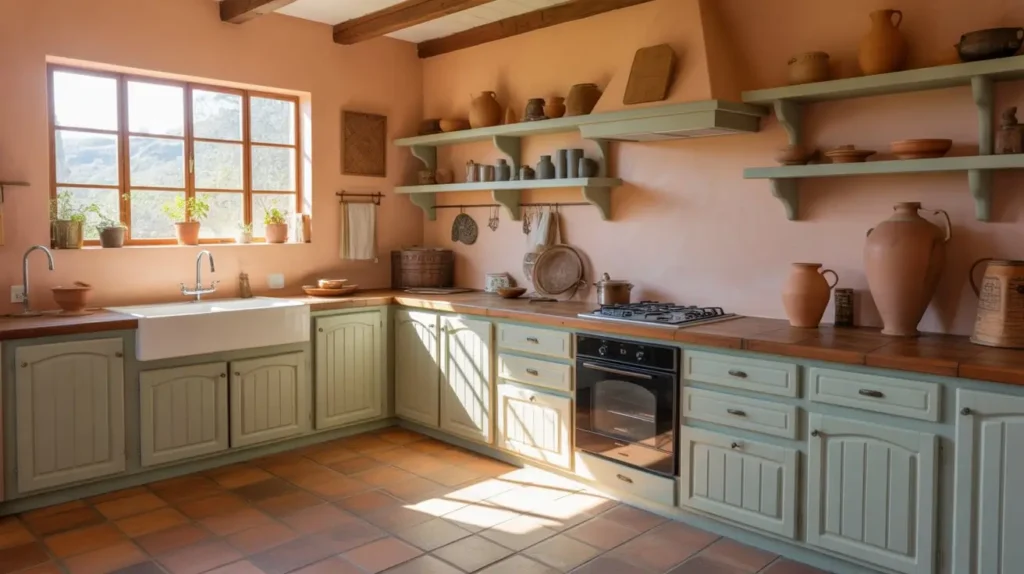
Okay, this might be my personal favorite on the list. The combination of sage green and terracotta creates this earthy, Mediterranean-inspired vibe that feels warm and inviting.
Sage green cabinets form the base, and then you bring in terracotta through tiles, pots, accessories, or even a terracotta-colored range. The warm orange-brown tones of terracotta and the cool earthiness of sage create this perfect balance.
Ways to incorporate terracotta:
- Terracotta tile backsplash or floor
- Clay pots displayed on open shelving
- A terracotta-colored range (like certain La Cornue or Lacanche models)
- Tile accents or a decorative tile feature
- Terracotta canisters or kitchen accessories
This combination reminds me of Tuscan villas and Spanish haciendas—warm, sun-drenched, and full of life. It works beautifully with natural materials like wood, stone, and linen.
The key is balance. Too much terracotta can overwhelm, so use it as an accent rather than a dominant color. Let the sage green do the heavy lifting while terracotta adds those warm pops of color.
Scandinavian Sage Green Kitchen Design
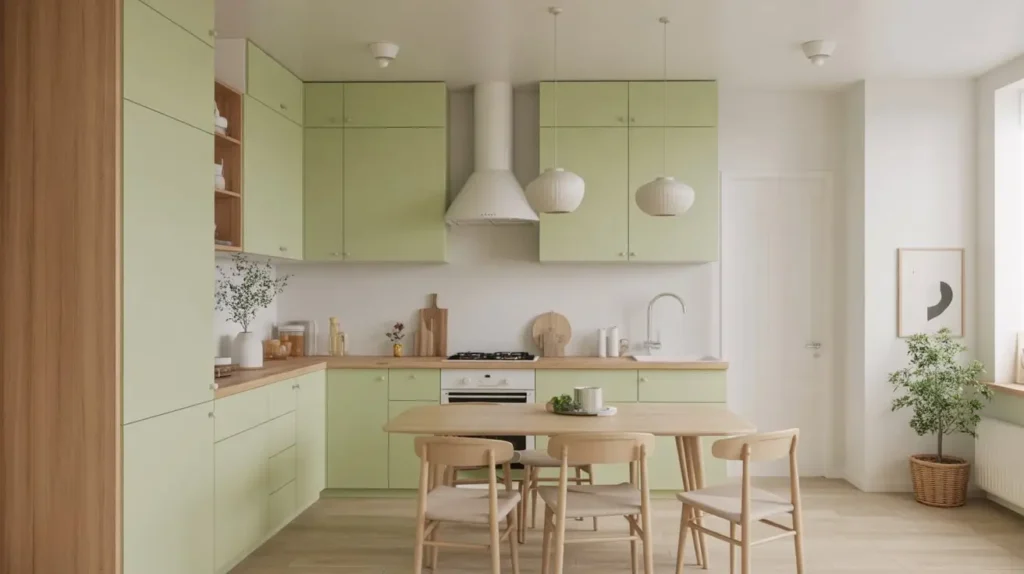
Scandinavian design is all about simplicity, functionality, and creating calm, beautiful spaces with minimal fuss. Sage green fits perfectly into this aesthetic.
Think light sage green cabinets (on the paler end of the spectrum), white walls, light wood floors, and tons of natural light. The Scandinavian approach emphasizes clean lines, quality materials, and a restrained color palette.
Scandinavian design principles:
- Light wood tones: Birch, ash, or light oak
- White as a primary color: Keeps spaces bright during long, dark winters
- Minimal ornamentation: Simple hardware, clean lines
- Natural light: Maximize it with minimal window treatments
- Plants: Greenery brings life to the neutral palette
The sage green in a Scandinavian kitchen should feel subtle and soothing, not bold or dramatic. It’s about creating a sense of peace and order—a kitchen where everything has its place and the whole space feels calming.
I love how this style prioritizes quality over quantity. You choose fewer, better pieces rather than filling every inch of space. The sage green adds just enough color to keep things interesting without disrupting the serene vibe.
Bringing It All Together
So there you have it—15 different ways to incorporate sage green into your kitchen, each with its own personality and vibe. The beauty of sage green is its incredible versatility. It works with brass and gold, plays nicely with black and white, complements wood tones, and creates stunning combinations with everything from marble to terracotta.
Whether you’re drawn to the cozy cottage vibe, the sleek modern aesthetic, or something in between, sage green can work for you. The key is choosing the right shade—dusty sage for minimalist spaces, brighter sage for farmhouse kitchens, muted sage for Scandinavian designs.
My honest advice? Get a bunch of paint samples and live with them for a few days. Look at them in morning light, afternoon light, and evening with your lights on. Sage green can shift dramatically depending on lighting, so what looks perfect in the store might look completely different in your actual kitchen.
And remember, you don’t have to commit to painting all your cabinets right away. Start with an island, or paint just the lowers. Bring in sage through accessories—dish towels, a small appliance, some pottery on open shelves. Test the waters before you dive in headfirst.
Your kitchen should make you happy every single time you walk into it. If sage green does that for you (and I suspect it will), then go for it. Life’s too short for boring kitchens, right? 🙂



